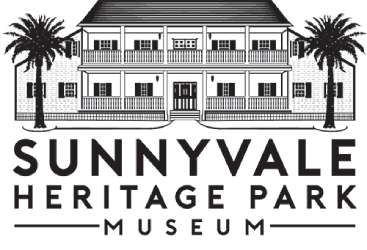“Sunnyvale Standard”, October 18, 1918
Proclamation: By authority invested in me as Commissioner of Public Health and Safety of the town of Sunnyvale, I hereby request and order that all Picture Shows, Churches, Lodges and all public meetings of any kind whatsoever be discontinued until further notice. This order made owing to the epidemic of Spanish influenza now prevalent in the county.
H.R.Fuller, Commissioner of Public Health and Safety, Town of Sunnyvale. By Order of Town Council. Sunnyvale, Cal.
Although this proclamation resonates well with the residents of Sunnyvale in 2020 who have experienced weeks of “shelter-in-place”, it was issued over 100 years ago in the “Sunnyvale Standard”, October 18, 1918. At that time the world was in the grip of another major pandemic, the Spanish Flu. The Spanish Flu Pandemic surfaced in early 1918, and before it was over, an estimated 50 million people died worldwide in three successive influenza waves. The United States alone recorded 550,000 deaths.
During World War I the flu reached epidemic proportions in Europe, with both American and German soldiers suffering massive numbers of flu fatalities. Civilians, too, were greatly affected; many have compared it to Europe’s Black Death of 1348 and the Great Plague of 1665. The Spanish Flu greatly taxed the world’s medical profession, already burdened with the casualties of war. Age groups recording the highest Spanish Flu mortality rates were 0-5 years, 20-40 years, and above 65 years.
The Spanish Flu in California
The disease was thought to have come to California by soldiers returning home from Europe. In 1918, health officials throughout the state published guidelines to help stop the spread of the influenza. Many of the guidelines were the same as some that we have been practicing in 2020: keep away from large groups and stay home if ill. But the wording of others appears strangely humorous in today’s more enlightened world. The Los Angeles City Health Commissioner published the following guidelines in October, 1918:
To Avoid Influenza:
- Avoid the person who sneezes and coughs without a handkerchief.
- Avoid the person who spits where it will spread disease. He is dangerous as well as indecent.
If You Catch Influenza:
- Do not spit on sidewalks, floors, street cars or places where germs will spread.
- Boil your handkerchiefs after they are washed.
- Keep your bowels open.
Many citizens protested the guidelines, especially the shutdown of funerals, movie theaters, and church services. Racial problems surfaced, too. More than 100 student nurses at Los Angeles County Hospital resigned when the hospital supervisors allowed African American women to work alongside the nurses.
San Francisco’s first known case of Spanish Flu was diagnosed in September, 1918. By the end of October, the number of cases had risen to nearly 20,000. Like the residents of Los Angeles, San Franciscans were issued guidelines which grew even stricter as the number of cases increased. Eventually, city officials determined that all of San Francisco’s residents, not just health care workers, must wear masks outdoors at all times. Those who did not were considered unpatriotic, likely to be arrested or fined. According to the Red Cross, “the man or woman or child who will not wear a mask now is a dangerous slacker”.
When the number of influenza cases decreased enough to allow the lifting of the mask requirement, “residents ripped the hated masks from their faces and unceremoniously tossed them in the streets.” According to the “San Francisco Chronicle”, “the sidewalks were strewn with the relics of a tortuous month”. The celebrating did not last long. Due to a resurgence of the disease in early December, residents were once again ordered to wear masks. Because many people refused to adhere to the renewal of the strict guidelines, the fall of 1918 and the winter of 1919 saw a great increase in victims; 45,000 San Franciscans were stricken with the influenza and 3,000 died, one of the nation’s highest flu and death rates for a city of its size.
San Jose Normal School, now San José State University, felt the brunt of the Spanish flu in October, 1918. The school closed down in the middle of October, reopened in November, then closed down again in December. When in session, the students were required to make their own reusable cloth masks and wear them to school. The Intermediate Building on campus was transformed into the Normal Hospital, and meals for the patients were cooked by the school’s Household Arts department. The student body, mainly women, volunteered as untrained nurses. Students and faculty donated cots, bedding, clothing, food, and flowers to those who were ill.
By the summer of 1919, the worst of the flu pandemic came to an end throughout the country, mainly due to the increase in wide-scale immunity.
What have we learned?
From their studies of the Spanish Influenza, today’s historians have uncovered lessons that shed light on the current Coronavirus Pandemic. According to Huntington Library archivist Joel Kline, the greatest lesson to reflect upon is this: “we will get through this best if we all work together”. In countless ways, including social-distancing, following the directives for wearing masks, creating posters and sidewalk messages of hope, and showing gratitude for healthcare workers, everyone working together will finally bring an end to the Pandemic of 2020.
Resources:
1. Arnold, Catharine. Pandemic 1918: The Story of the Deadliest Influenza in History. London: Michael O’Mara, Publisher, 1918
2. Arellano, Gustavo. “This isn’t the first time a virus caused social panic.” Los Angeles Times. March 16, 2020: Internet.
3. “The American Influenza Epidemic of 1918-1919: San Francisco, CA”. Influenza Encyclopedia. Univ. of Michigan Center for the History of Medicine, April 21, 2020.

